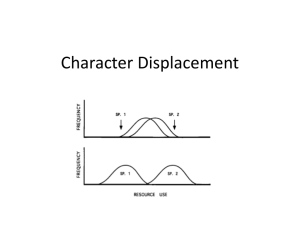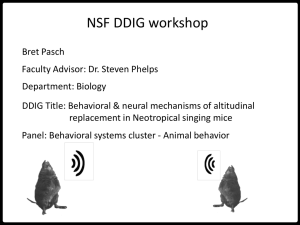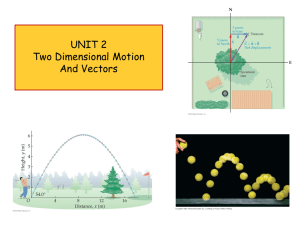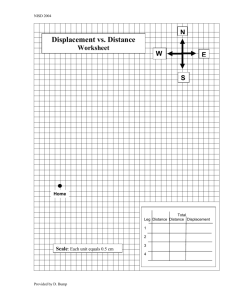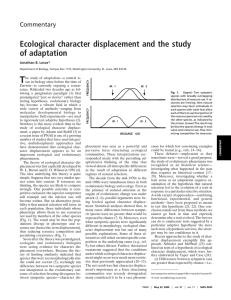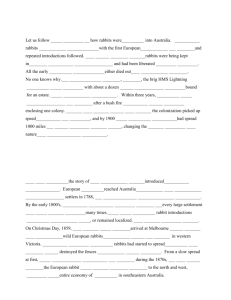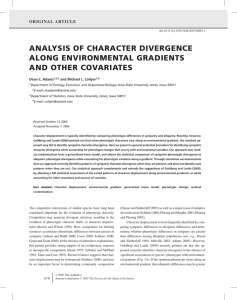11_Coevol
advertisement
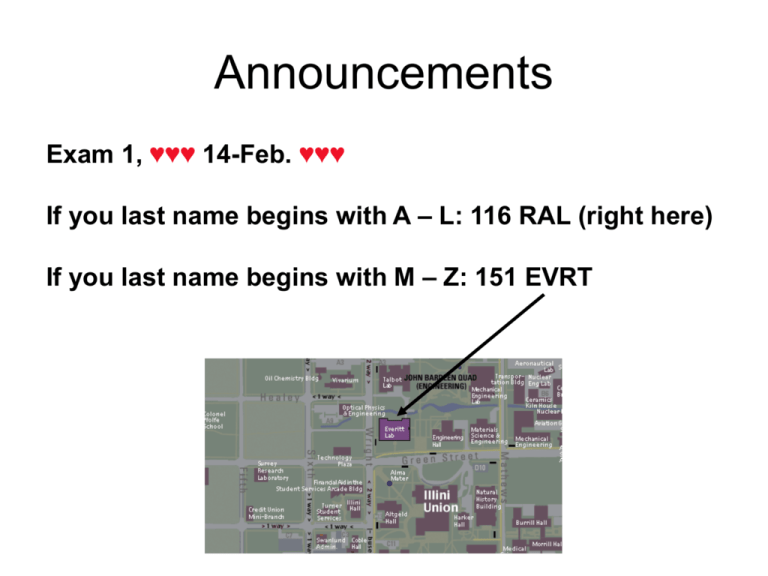
Announcements Exam 1, ♥♥♥ 14-Feb. ♥♥♥ If you last name begins with A – L: 116 RAL (right here) If you last name begins with M – Z: 151 EVRT Coevolution = The occurrence of genetically determined traits in two or more species selected by the mutual interactions controlled by these traits. -Ricklefs Species Interactions: - Mating (usually -,-) - Competition (-,-) - Predator-prey (+,-) - Mutualism (+,+) Character Displacement Fig. 20.12; Ricklefs “Economy of Nature” Displacement of beak size and diet Fig. 20.13; Ricklefs “Economy of Nature” What kinds of interactions can lead to character displacement? “Reproductive Character Displacement” Hybridization between species (mate recognition) “Ecological Character Displacement” Competition – for resources Optimal Threshold Model signals you want to accept signals you want to reject acceptance errors rejection errors adapted from Reeve 1989, Starks 2003 Species A Allopatry Accept T Reject Frequency Reject Frequency Accept T ??? Species B Allopatry Dissimilarity between template and cues Dissimilarity between template and cues To avoid costly mistakes (i.e., mating with the wrong species): Signal Perception Cue Receiver Signaler Reject Frequency Accept T Dissimilarity between template and cues Green Tree Frog Hyla cinerea Barking Tree Frog Hyla gratiosa Sympatry Allopatry Male Hyla cinerea songs differ In allopatry and sympatry (with H. gratiosa) Sympatry Allopatry Female Hyla cinerea preference differs in allopatry and sympatry Hybrid calls are unattractive! Höbel and Gerhardt 2003, Evolution Greenish Warbler, Phylloscopus trochiloides Irwin et al. 2000, Nature A B C Birds from A and C respond to each other’s mating calls. Birds of both species at B don’t respond to each other. “Ring” Species Response to songs is a function of distance: 2 co-occurring species in the Caribbean One morphologically specialized to trunk life The other specialized for life in the branches Hurricane 1. A and B live in sympatry A on trunk B on branches 3. Species A reintroduced (allopatry with B) 2. No species 4. Species A on trunk and branches Evidence for developmental flexibility Anolis lizards: morphology of hind legs changes when raised on large trunks or small branches. Losos et al. 2002 Evolution Anole • Rapid evolution of species A? • Character displacement when in sympatry? If yes, then what character? Answer: phenotypic plasticity (environment) Species A Long leg and Short leg Species A – long leg Species B – short leg Species B Long leg and Short leg Brief Recap • Green Frogs: displacement of both male call and female preference in sympatry • Greenish Warbler: ring species; female call preference in sympatry • Sticklebacks: displacement of male preference in sympatry (differentiating from the role of the environment); ultimate and proximate explanations • Anoles: competition repressing plasticity Predation/Parasitism • Having your life threatened by another organism is a heavy selection pressure. • Getting enough to eat, especially when you are very specialized, is a heavy selection pressure. Evolutionary Arms Races BOOM! The Red Queen Hypothesis Red Queen said to Alice: “…it takes all the running you can do, to keep in the same place.” Lewis Carroll, “Through the looking glass” Predation/Parasitism Coyotes discover rabbits are food Rabbits that don’t avoid coyotes are eaten Some rabbits are able to hide from coyotes Coyotes can’t catch as many rabbits Some coyotes are able to smell rabbit pheromone Rabbits using the pheromone are eaten Only rabbits that have altered the pheromone live Predator-Prey, Host-Parasite Coevolution • Bat predators are specifically tuned to the songs of their frog prey. Social parasites mimic recognition properties of their hosts. photograph © Alex Wild 2004 Mutualisms • Mutualism = a relationship between two species that benefits both. – Ricklefs • Mututalists have complimentary functions – Obligate: they cannot survive without each other – Facultative: they each do better when both are present • Obligate mutualisms have been pivotal in major evolutionary advances. Types of Mutualisms • Trophic – partners provide nutrients that can’t be obtained individually. – Digestive bacteria, Lichens • Defensive – one partner defends the other in exchange for food, shelter, or etc. – Ants and plants, humans and chickens (?) • Dispersive – one partner transports something for the other in exchange for food, or etc. – Pollination
